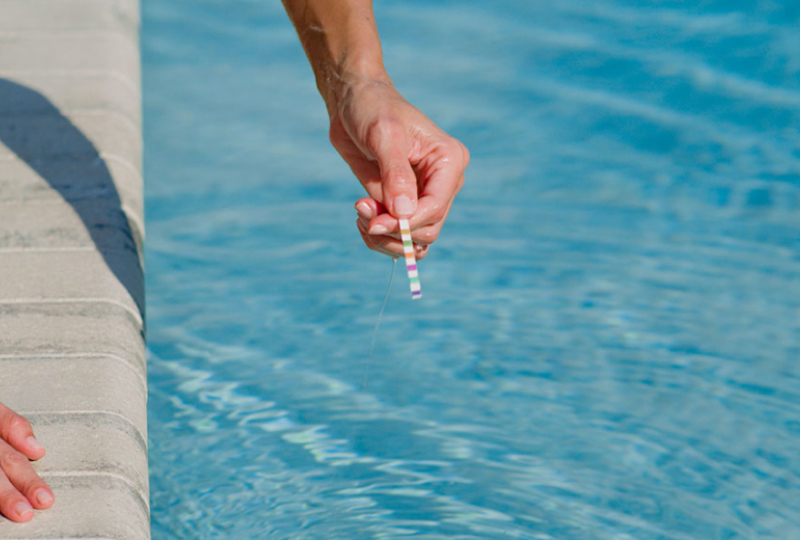
Balancing Pool Water
Balancing your pool water means ensuring the total alkalinity, pH, and calcium hardness are within their proper levels. Properly balanced water is crucial to keeping your pool clean and clear.
Maintaining proper pool water balance involves regularly testing your pool water and adding pool chemicals. Balancing pool chemicals may be time-consuming, but learning how to do it well will help avoid many pool problems.
When your pool water isn’t balanced, your sanitizer may not work as effectively, resulting in cloudy pool water, algae blooms, and bacteria buildup. Properly balanced pool water will also prolong the life of your pool equipment.
Besides avoiding common pool water issues, balancing pool water helps chemicals work more effectively and for longer, creating cost savings

How To Balance Pool Water
1. Gather Necessary Supplies
The following items will be required:
- Pool test strips or digital pool tester
- Alkalinity balancer
- pH balancer
- Water-hardness balancer
2. Calculate Pool Volume
Knowing your pool volume is necessary to dose your pool properly. You can determine the volume of your pool by using our pool volume calculator.
3. Perform the Test
Perform the water balance test by following the manufacturer’s instructions on your pool test strips or digital pool tester. Make sure the test covers the following components: total alkalinity, pH, and calcium hardness.
4. Test and Adjust Total Alkalinity (TA)
Your pool’s Total Alkalinity (TA) is the number of alkaline substances present in your pool water. Alkalinity is a pH stabilizer, so the amount of alkaline material in your water will affect the pH balance. Maintaining the correct total alkalinity level will help prevent unwanted changes to pH.
The ideal pool alkalinity range is 80-120 ppm. If there’s low alkalinity in pool water, increase the TA by using sodium bicarbonate (baking soda). If alkalinity is too high, add muriatic acid or sodium bisulphate (dry acid for pools) to decrease alkalinity in pool water.
5. Test and Adjust pH
pH is a measurement of the degree to which water is acidic or basic. pH ranges from 1.0 to 14.0, with 7 being neutral. pH readings from 0 to 7.0 cover the acidic range, whereas 7.0 to 14 cover the alkaline (basic) range. The ideal pool pH level is 7.4-7.6.
When the pool pH is too high, the water becomes too alkaline, which reduces the effectiveness of chlorine. It can also create skin rashes, cloudy pool water, and scaling on pool equipment. Low pH causes eye and skin irritation and can corrode pool equipment and plaster in gunite pools.
To raise pH in pool water, use a pH increaser such as sodium carbonate (soda ash). To lower pH in pool water, add a pH decreaser such as sodium bisulphate or muriatic acid.
If your pH fluctuates during testing, the TA may be too low. You can correct that by adding baking soda to increase alkalinity and stabilize pH.
6. Measure and Adjust Calcium Hardness
A pool calcium buildup is directly related to your pool’s calcium hardness level. Often appearing as a white line or scaling near your pool’s waterline, pool calcium buildup looks dirty and can damage pool material and equipment.
The ideal calcium hardness in pool water is 200-400 ppm. To increase your pool’s calcium hardness, add calcium chloride. If you need to decrease calcium hardness, you’ll need to partially drain your pool before refilling it with fresh water. If the source water is high in calcium, use a pre-filter to help reduce the surplus minerals in the water.
You can also use a pool flocculant to remove excess calcium hardness. For this method to be effective, you will need to increase the pH to 8.2 to take the calcium out of the solution. The calcium may cause a film on the pool walls, which you need to scrub off. Use the pool floc to coagulate the excess calcium and vacuum the larger particles to waste.
Common Problems With Pool Ph And Total Alkalinity
Total Alkalinity and Pool pH Are Both Low
Add a pH increaser if both the pH and alkalinity levels are low in pool water.
Total Alkalinity and Pool pH Are Both High
If both the pH and alkalinity levels are high in pool water, use a pH reducer, also known as dry acid for pools.
Low Pool pH and High Total Alkalinity in Pool Water
When the pool alkalinity is too high but the pool pH is too low, make repeated adjustments of lowering the alkalinity and then raising the pH until both arrive at the proper ranges. Before adding more chemicals, test the water each time.
Pool pH is High, Total Alkalinity Is Low
To raise the TA level when the pH is too high, start by adding an alkalinity increaser. This may also cause a slight increase in the pH level. Once you achieve the proper TA level, you can lower the pH in the pool water with pH reducer. Repeated alternating adjustments may be necessary to achieve the proper levels.

